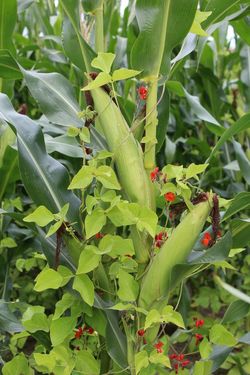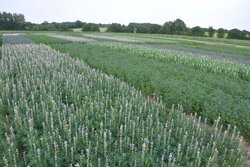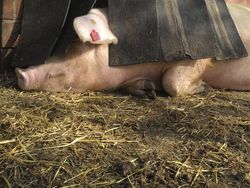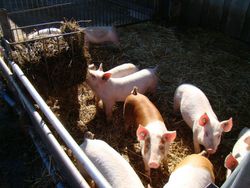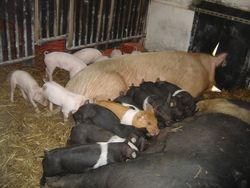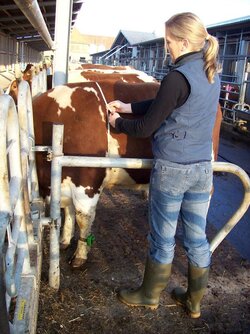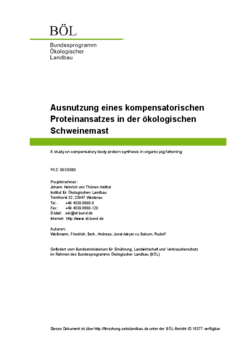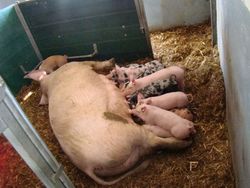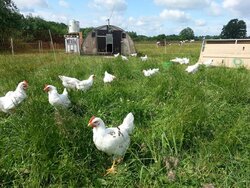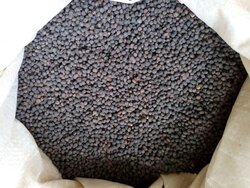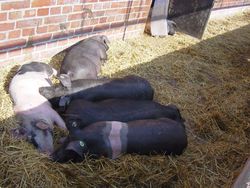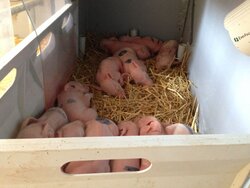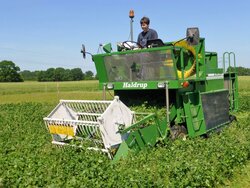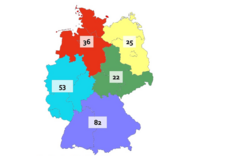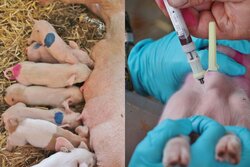Expertise
Organic pig farming
Ralf Bussemas and Lisa Baldinger | 01.06.2022
Similar to conventional farming, organic pig farming is based on a specialisation on certain branches. Most farms specialise in piglet production or pig fattening. The "closed system", in which piglet production and fattening take place on the same farm, is less common.
The piglets that the sow has given birth to are thus raised by the piglet producer up to a weight of around 27 kg. They are then sold to fattening farms, where they are fattened up to a final weight of around 120 kg and then slaughtered.
While the differences between organic and conventional pig farming are rather gradual in terms of breeds, there are very marked differences in stocking rate, animal husbandry, feeding and disease treatment, which are briefly outlined below. Whether the requirements of organic farming are met is checked within the framework of certification by means of farm inspections that take place at least once a year. Sanctions can be imposed for non-compliance.
The sows are mostly cross-bred animals from the breeds "Deutsches Landschwein" and "Deutsches Edelschwein". Depending on the marketing objective, the breeds "Piétrain" or, more rarely, "Duroc" are predominantly used for the final stage boars.
While conventional piglet production is very uniform, organic piglet production is characterised by a variety of individual farm solutions in the choice, origin and combination of breeds. The use of so-called old breeds such as "Angler Saddle Pig", "Bunte Bentheimer Pig" or "Schwäbisch-Hällisches Pig" is not a question of organic or conventional farming, but depends on the demands that marketers and processors place on carcass quality. The choice of breeds may therefore have an influence on marketing opportunities.
The quality of the meat - especially sensory characteristics such as tenderness, juiciness and aroma - plays little role in the price the fattener can fetch. Either the payment is based on a fixed price per pig or according to certain criteria, the so-called price mask, which is based, for example, on the lean meat content of the carcass.
The minimum space allowance is shown in the following table using the example of lactating sows, piglets and fattening pigs. Because of these space requirements organically kept pigs have significantly more space than conventionally kept pigs. (Table)
| Stable (m2 per animal) | Adjacent run (m2 per animal) | |
|---|---|---|
| Nursing sow (incl. piglets up to 40 days) | 7,5 | 2,5 |
| Piglets older than 40 days and weighing max. 30 kg | 0,6 | 0,4 |
| Fattening pigs up to 50 kg live weight | 0,8 | 0,6 |
| Fattening pigs up to 85 kg live weight | 1,1 | 0,8 |
| Fattening pigs up to 110 kg live weight | 1,3 | 1,0 |
| Fattening pigs above 110 kg live weight | 1,5 | 1,2 |
All farm animals and thus also pigs may only be fed with organically produced feed.
In contrast to conventional farming, organically reared pigs must be offered roughage or basic feed in addition to concentrated feed. Very often straw is provided in separate pens. The best choice is clover grass in the form of silage, which accumulates in the crop rotation.
When feeding concentrate feed, all ration components such as cereals, grain legumes or their processed products must be of organic origin. The biggest problem here is the so-called protein gap (protein gap). This means the lack of ration components of organic origin with sufficient essential amino acids. These so-called first and second limiting amino acids (above all lysine and methionine) are essential building blocks for healthy metabolic processes and the body's own protein build-up.
A corresponding deficiency in piglet rearing can lead to growth depression and susceptibility to disease, even death. In fattening pigs, on the other hand, only the body's own protein synthesis is reduced, resulting in somewhat fatter pigs. Thus, the lean meat content in conventional fattening ranges approximately between 58 and 60 %, whereas under organic conditions usually around 54 to 56 % is achieved.
To bridge the protein gap, organic farms are currently allowed a maximum of 5 % protein feed of non-organic origin in the feed ration for piglets up to 35 kg until the end of 2025, based on a temporary derogation; this is usually potato protein.
In principle, there is a duty to treat sick animals effectively and immediately. While e.g. vaccinations and deworming are fully permitted, the use of antibiotics for curative purposes is subject to very strict regulations.
For animals over one year of age, antibiotic treatment may be administered a maximum of three times per year. For animals less than one year old, antibiotic treatment may be given for no more than one disease. If this minimum number has to be exceeded for treatment reasons, the animals concerned lose their organic status.
In the interest of animal welfare, routine manipulations such as grinding the teeth of suckling piglets to protect the sow's teats and docking tails as a preventive measure against tail biting are generally prohibited in organic animal husbandry. Only in individual cases may such measures be carried out after individual veterinary indication and approval by the inspection body.
At this point, we would like to take a look at an example of a breeding aspect: In case of shortages in the supply of organically reared gilts, the EU Organic Farming Regulation currently still allows the purchase of animals of conventional origin. However, these must not weigh more than 35 kg. This regulation will, however, expire.
Although there are practical recommendations for piglet producers to organise their own breeding of gilts, this method has the disadvantage that only half of the breeding progress can be used. This is because, when mating a mother sow selected on the farmer's own piglet farm, this only comes via (the semen of) the sire's side. Therefore, as an additional option, organically managed gilts multipliers should be integrated into commercial breeding companies. Gilts raised there combine in themselves the full parental breeding progress from the mother's and father's side of the organisationally upstream breeding stage.
Until such a system has become established, the retention of the derogation for the purchase of animals makes sense from a breeding point of view. Nevertheless, it must be backed up with a clear exit scenario in terms of time, as otherwise a decisive incentive to organise special organic gilts reproduction is missing.

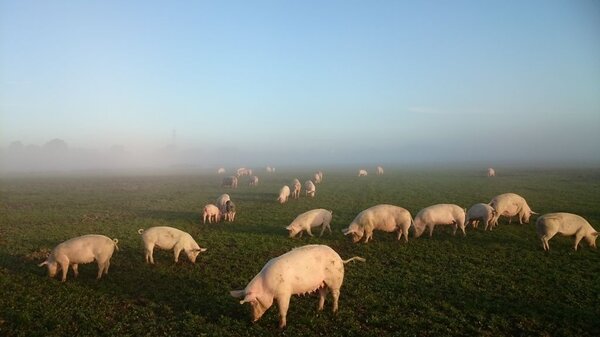
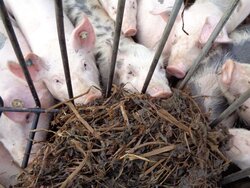
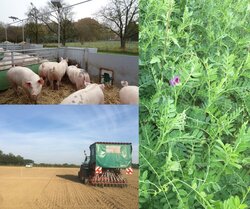
![[Translate to English:] Common vetch: variety testing for agronomy and feeding of fattening pigs](/media/_processed_/b/1/csm_Wick4Pig_Homepage_Th%C3%BCnen-Honsdorf__Stepczynskk_Wiskandt_4a87a0e49f.jpg)
